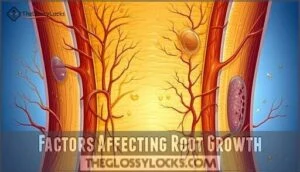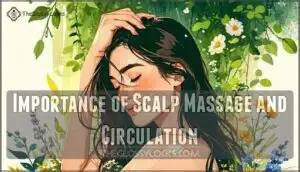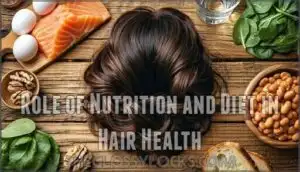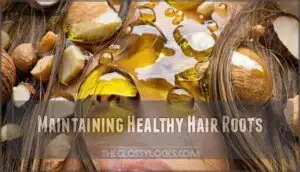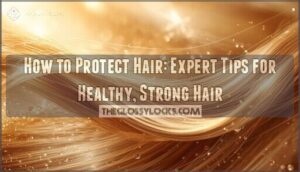This site is supported by our readers. We may earn a commission, at no cost to you, if you purchase through links.
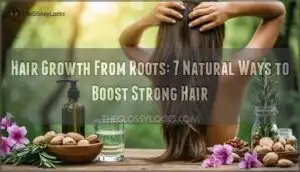
You’ll need to massage your scalp regularly, use nourishing oils like castor or rosemary, and maintain a balanced diet rich in proteins and vitamins.
Gentle care routines protect your hair follicles from damage, while reducing heat styling gives your roots time to recover.
Essential nutrients reach your hair through good circulation, so staying hydrated and managing stress levels also plays a vital role.
The secret lies in understanding your hair’s natural growth cycle and working with it, not against it, to discover your hair’s full potential.
Table Of Contents
- Key Takeaways
- Hair Growth Basics
- Factors Affecting Root Growth
- Promoting Healthy Root Growth
- Natural Treatments for Hair Growth
- Maintaining Healthy Hair Roots
- Frequently Asked Questions (FAQs)
- Can hair regrow from roots?
- How can I grow my hair from roots?
- Does your hair grow from your roots or ends?
- Can damaged hair roots actually regenerate completely?
- How long before new root growth becomes visible?
- Does root growth speed change with age?
- Are there medical treatments for stimulating root growth?
- Conclusion
Key Takeaways
- Massage your scalp daily – Regular scalp massage boosts blood circulation and delivers essential nutrients directly to your hair follicles, stimulating growth from the roots up.
- Nourish with natural oils – Use rosemary, coconut, or castor oil to strengthen follicles and block the DHT hormone that causes hair thinning, applying these oils consistently for best results.
- Feed your follicles properly – Eat protein-rich foods, iron, vitamins, and stay hydrated since your hair needs these nutrients to build strong keratin and maintain healthy growth cycles.
- Protect and be gentle – Reduce heat styling, manage stress levels, and use gentle hair care routines to prevent damage that can weaken roots and disrupt your hair’s natural growth phases.
Hair Growth Basics
Your hair’s journey starts deep in your scalp, where follicles work around the clock to create each strand from the root up.
Understanding how this complex growth cycle operates helps you make smarter choices about caring for your hair and encouraging stronger, healthier growth.
Hair Growth Cycle Phases
Your hair’s growth cycle operates like a well-oiled machine, cycling through distinct phases that determine your hair’s health and thickness.
Understanding these phases helps you optimize your hair care routine and identify potential issues before they become problems.
Here’s how your hair growth cycle works:
- Anagen Duration spans 2-7 years, actively growing hair at the follicle level
- Catagen Triggers signal a brief 2-3 week period when growth slows
- Telogen Shedding occurs during the 3-month resting phase before new growth begins
- Cycle Disruption from stress or illness can push more follicles into premature shedding
Anagen, Catagen, and Telogen Phases
Your hair cycle runs like clockwork through three distinct phases.
Your hair’s growth happens in perfectly timed cycles that never stop working.
The anagen phase drives active growth for two to seven years, determining your hair’s maximum length. During catagen, follicles shrink and prepare for rest, signaling the end of growth.
Telogen brings natural shedding as old hairs fall out. Normal shedding occurs during the exogen phase.
When cycle disruption occurs, you’ll notice increased hair loss or stunted growth, affecting your follicle cycling patterns.
Hair Follicle Structure and Function
Deep within your scalp, hair follicles function as sophisticated biological factories.
These structures house Follicle Stem Cells that receive Dermal Papilla Signals to initiate Hair Matrix Activity.
The follicle’s architecture includes the bulb where Melanocyte Interaction occurs, producing pigment.
This complex Follicle Microenvironment coordinates the hair growth cycle, with dermal papilla cells controlling when follicles shift between active and resting phases.
Role of Dermal Papilla in Hair Growth
Located at your follicle’s base, the dermal papilla acts as mission control for hair production.
These specialized cells orchestrate the entire growth process through sophisticated cellular communication networks.
Here’s how dermal papilla cells control your hair’s destiny:
- Papilla Cell Signaling – Send chemical messages that activate surrounding matrix cells
- Matrix Cell Proliferation – Trigger rapid cell division that forms new hair strands
- Follicle Neovascularization – Promote blood vessel formation for nutrient delivery
- Growth Factor Influence – Release proteins that determine hair thickness and growth rate
Think of dermal papilla cells as your hair’s personal trainers, constantly pushing matrix cells to multiply and create keratin.
When these cells receive proper nutrients and oxygen, they maintain efficient signaling throughout your hair growth cycle.
Dermal Papilla Regeneration becomes vital when follicles weaken, as healthy papilla cells can restart dormant hair production and extend your follicle’s lifespan.
Factors Affecting Root Growth
Your hair’s roots face constant challenges that can slow or stop healthy growth.
From your genes to your daily habits, several key factors determine whether your follicles produce strong, thick strands or struggle to maintain normal growth patterns, including complete concepts such as genetic predispositions and environmental influences, which can be summarized as daily habits.
Genetic Predisposition and Hair Loss
Your genetic blueprint determines your hair’s destiny.
Your hair’s fate is written in your genes, but you can still rewrite the story.
Family history plays a starring role in androgenetic alopecia, the most common form of genetic hair loss.
If your parents struggled with thinning hair, you’re likely carrying those predisposition triggers.
| Genetic Factor | Impact on Hair | DHT Sensitivity |
|---|---|---|
| Maternal genes | 40% hair loss risk | High receptor activity |
| Paternal genes | 30% hair loss risk | Moderate sensitivity |
| Combined inheritance | 70% hair loss risk | Maximum follicle shrinkage |
Gene therapy research shows promise for reversing genetic predisposition, but current treatments focus on managing DHT levels and supporting existing follicles through natural methods.
Hormonal Imbalances and Hair Growth
Beyond genetics, hormonal imbalances dramatically impact hair growth by disrupting your follicle’s natural cycle.
DHT and hair loss go hand-in-hand, with elevated dihydrotestosterone shrinking follicles and shortening growth phases.
Estrogens influence extends the anagen phase, creating thicker strands during pregnancy but causing postpartum shedding.
PCOS effects include androgenetic alopecia from excess androgens, while thyroid impact affects both hypo and hyperthyroidism cases.
Hormone levels substantially influence hair thickness and quality.
Hormone therapy can restore balance and promote regrowth, addressing issues related to hair thickness and hair quality, by correcting hormonal imbalances.
Nutritional Deficiencies and Hair Health
Your body can’t manufacture hair without the right fuel.
Iron Deficiency starves follicles of oxygen, while inadequate Protein Intake weakens hair structure since strands are 95% protein. Vitamin Deficiencies and Mineral Imbalance disrupt growth cycles, making follicles sluggish.
Even Hydration Effects matter—dehydrated cells can’t transport nutrients effectively to roots. A balanced diet with omega-3 fatty acids can improve scalp health.
- Iron Deficiency reduces oxygen delivery to hair follicles, causing premature shedding and slower growth rates
- Protein Intake below daily requirements weakens keratin production, leading to brittle, thin strands that break easily
- Vitamin Deficiencies in biotin, vitamin D, and zinc disrupt cellular processes essential for healthy hair formation
Stress and Its Impact on Hair Growth
When you’re constantly stressed, your body doesn’t just feel it—your hair follicles do too.
Chronic stress elevates cortisol levels, pushing hair into telogen effluvium, where healthy strands prematurely enter the resting phase.
This creates scalp tension and disrupts your natural hair growth cycle.
Managing stress through relaxation techniques helps restore hormonal balance and prevents unnecessary hair loss, promoting a return to a healthy state of hair growth and reducing the impact of chronic stress.
Promoting Healthy Root Growth
Now that you understand the factors affecting root growth, it’s time to actively promote healthy hair development from the source.
You can strengthen your hair follicles and boost circulation through targeted approaches that work with your body’s natural growth processes, which can help in healthy hair development.
Importance of Scalp Massage and Circulation
Your scalp’s circulation acts like a highway system delivering nutrients straight to your hair follicles.
Scalp massage techniques boost blood flow and stimulate growth factors that keep follicles healthy and active. A scalp massager tool can further enhance these benefits.
Circulation Benefits:
- Increases nutrient delivery to hair roots
- Stretches follicle cells for thicker growth
- Removes buildup that blocks follicles
- Reduces stress hormones affecting hair
- Activates dormant follicles for new growth
Benefits of Essential Oils for Hair Growth
Why struggle with thinning hair when essential oils can release your follicles’ potential? Research shows rosemary oil matches minoxidil’s effectiveness, while peppermint oil boosts circulation better than traditional treatments.
These natural powerhouses work by stimulating blood flow and blocking DHT production. Essential oils like lavender can also delay the catagen phase, potentially lengthening the active growth cycle.
| Oil Type | Primary Benefit | Application Method |
|---|---|---|
| Rosemary Oil | Blocks DHT, promotes thickness | Mix with carrier oil, massage scalp |
| Peppermint Oil | Enhances circulation, follicle depth | Dilute 2-3 drops in jojoba oil |
| Lavender Oil | Reduces inflammation, antimicrobial | Blend with coconut oil, leave overnight |
| Cedarwood Oil | Balances oil production | Add to scalp treatment blend |
| Tea Tree Oil | Fights dandruff, cleanses follicles | Mix with shampoo, use sparingly |
Role of Nutrition and Diet in Hair Health
Your body operates like a well-oiled machine, but it needs the right fuel to power hair growth from the roots.
Nutrition directly impacts how your follicles function, and smart Food Choices can transform weak strands into strong, healthy hair.
- Protein powerhouses: Eggs, fish, and beans provide building blocks for keratin production
- Iron-rich foods: Spinach, lentils, and red meat boost oxygen transport to follicles
- Vitamin D sources: Fatty fish and fortified foods stimulate new follicle generation
- Zinc champions: Shellfish, seeds, and legumes support tissue growth and repair
- Omega-3 allies: Walnuts, flaxseeds, and fish oil nourish your scalp environment
The Dietary Impact on hair growth becomes obvious when you consider Nutrient Absorption patterns.
Your follicles depend on vitamins and minerals traveling through your bloodstream.
Hydration Effects also play a role—water helps transport these nutrients while keeping hair flexible.
Supplement Strategies can fill nutritional gaps, but whole foods remain your best bet for a nutrient-rich diet that supports lasting hair growth.
Impact of Lifestyle Habits on Hair Growth
Your daily habits shape your hair’s destiny more than you might think.
While nutrition lays the foundation, lifestyle choices determine whether your follicles thrive or struggle.
Poor sleep disrupts growth cycles, while dehydration starves roots of essential nutrients.
| Habit | Hair Growth Impact |
|---|---|
| Sleep and Hair | 7-9 hours promotes cellular repair and hormone balance |
| Hydration Effects | Adequate water transport nutrients to follicles effectively |
| Smoking Impact | Reduces blood flow, weakening hair structure substantially |
| Exercise Benefits | Improves circulation and reduces stress hormones naturally |
Your stress management techniques directly influence hair loss prevention.
Chronic tension triggers telogen effluvium, pushing follicles into premature rest phases.
Regular exercise benefits include improved scalp circulation and stress reduction, creating ideal conditions for robust hair growth.
Natural Treatments for Hair Growth
You don’t need expensive treatments when nature provides powerful solutions for hair growth. These proven natural remedies can strengthen your hair follicles and boost growth right from the roots.
Coconut Oil and Its Benefits for Hair
You’ll tap into coconut oil’s potential through its unique fatty acid profile that enables deep coconut penetration into hair follicles.
This tropical powerhouse reduces protein loss while nourishing your scalp microbiome, creating an environment where hair growth thrives.
Its antimicrobial properties provide infection prevention, keeping your scalp healthy and your hair follicles functioning optimally for stronger strands.
Using coconut oil for hair growth treatments can lead to significant improvements in hair health.
Rosemary Oil and Its Effects on Hair Growth
Research shows rosemary oil matches minoxidil’s effectiveness in promoting hair regrowth after six months of consistent use.
This herb works by enhancing blood circulation to your scalp, delivering essential nutrients directly to hair follicles for maximum growth.
Rosemary Benefits for Hair Growth:
- Follicle Stimulation – Increases cellular activity in hair roots, encouraging new strand development
- Scalp Health Enhancement – Improves circulation while reducing inflammation that blocks healthy growth
- Natural DHT Blocking – Helps prevent hormone-related hair thinning without harsh chemicals
Mix rosemary oil with a carrier oil before applying to avoid irritation and maximize absorption.
Onion Juice and Its Role in Promoting Hair Growth
Onion juice packs sulfur-rich compounds that strengthen hair roots and boost keratin production.
Clinical studies show 86.9% of participants experienced hair regrowth after six weeks of twice-daily juice application.
The sulfur content stimulates follicles, improves scalp circulation, and combats infections that block growth.
Simply apply fresh onion juice to your scalp for an hour before washing.
Regular use of onion juice can lead to improved hair growth benefits and a healthier scalp environment.
Aloe Vera and Its Soothing Effects on The Scalp
Soothing scalp irritation becomes effortless with aloe vera’s natural healing properties.
This miracle plant reduces dandruff, unclogs follicles, and creates the perfect environment for hair growth.
Apply vera gel directly to your scalp during massage sessions to boost scalp circulation.
The aloe benefits include deep hair nourishment and enhanced follicle care, making it essential for natural hair growth routines.
Maintaining Healthy Hair Roots
Once you’ve stimulated new growth, protecting those delicate hair roots becomes your next priority.
You’ll need to shift from aggressive treatments to gentle care routines that shield your follicles from damage while maintaining the healthy environment you’ve created, using gentle care to support your new hair growth.
Importance of Gentle Hair Care Routines
Your hair follicles need tender loving care to thrive.
Switch to gentle shampoo formulas that won’t strip natural oils from your scalp. Incorporate weekly hair masks for deep root nourishment, and practice scalp massage during your hair care routine.
Gentle styling prevents breakage while promoting healthy hair growth. These hair care tips protect your scalp health naturally, using gentle shampoo formulas and incorporating weekly hair masks.
Benefits of Reducing Heat Styling and Stress
Hot tools and high stress create a perfect storm for hair breakage, turning your follicles into casualties of modern life.
Your scalp health depends on embracing gentle care practices that protect your hair’s natural strength and promote steady growth from the roots up.
- Limit heat styling to once weekly, using protective sprays when necessary
- Practice stress reduction through daily meditation, exercise, or deep breathing techniques
- Choose air-drying over blow-drying to prevent cuticle damage and split ends
- Maintain consistent sleep patterns to support natural hair follicle repair cycles
Role of Protective Gear in Preventing Hair Damage
Throughout your hair growth journey, protective gear acts as your shield against environmental damage that can weaken roots and stunt growth.
Smart protection prevents breakage while supporting the hair growth cycle phases. Using the right protective hairstyles can make a significant difference in maintaining healthy hair roots.
| Protection Type | When to Use | Hair Damage Prevention |
|---|---|---|
| Hair Sunscreen | Outdoor activities, beach days | Blocks UV rays that weaken hair shafts |
| Heat Protectors | Before styling tools | Creates barrier against thermal damage |
| Hair Ties | Exercise, windy weather | Prevents tangling and mechanical stress |
| Scalp Caps | Swimming, harsh weather | Shields follicles from chlorine and elements |
| Hair Nets | Work environments, sleep | Reduces friction and breakage overnight |
These hair care tips transform your routine into a fortress of protection, ensuring your follicles stay healthy and productive.
Tips for Maintaining a Healthy Scalp and Hair Follicles
Beyond protective measures, consistent scalp health practices create the foundation for robust hair growth.
Regular scalp massage boosts circulation and promotes root stimulation, while proper hair hydration maintains follicle function.
Clean hair follicles absorb nutrients more effectively, supporting stronger root development.
- Weekly scalp massage increases blood flow and strengthens hair nourishment pathways
- Gentle cleansing routine removes buildup without stripping natural oils that support follicle care
- Balanced diet with protein and vitamins provides essential nutrients for healthy hair growth and root strength
Frequently Asked Questions (FAQs)
Can hair regrow from roots?
Like a phoenix rising from ashes, your hair follicles retain their regenerative power.
Yes, hair can regrow from roots if they’re healthy and undamaged, cycling through growth phases naturally throughout your lifetime, with complete concepts of hair regrowth being a natural process.
How can I grow my hair from roots?
You can boost hair growth from roots by massaging your scalp daily, eating protein-rich foods, taking biotin supplements, using rosemary oil, and managing stress effectively.
Does your hair grow from your roots or ends?
Your hair grows from the roots, not the ends.
The root, located in your follicle’s dermal papilla, produces new cells that push upward, creating length as they harden into the visible hair shaft you see.
Can damaged hair roots actually regenerate completely?
Your damaged hair roots can regenerate completely if the follicle structure remains intact. However, if the follicle’s dermal papilla is severely damaged or destroyed, complete regeneration isn’t possible.
How long before new root growth becomes visible?
Surprisingly, you’ll spot fresh baby hairs emerging from your scalp within two to three months after your follicles kickstart their growth cycle again.
Does root growth speed change with age?
Yes, your hair growth rate naturally slows as you age.
Peak growth occurs in your twenties and thirties, then gradually decreases due to hormonal changes, reduced circulation, and cellular aging processes affecting follicle activity.
Are there medical treatments for stimulating root growth?
Like a gardener tending barren soil, you’ve got several medical options to awaken dormant follicles.
Minoxidil boosts blood flow, finasteride blocks DHT hormone, and prescription treatments like corticosteroids can jumpstart growth when natural methods aren’t enough.
Conclusion
Remember, patience is a virtue that applies perfectly to hair growth from roots.
You can’t rush your hair’s natural timeline, but you can definitely support it with the right approach.
These seven natural methods work together to create ideal conditions for strong, healthy growth.
By massaging your scalp regularly, using nourishing oils, eating nutrient-rich foods, and managing stress, you’ll give your hair follicles everything they need to thrive.
Consistency with these gentle practices will reward you with the strong, vibrant hair you’ve been seeking.
- https://www.ncbi.nlm.nih.gov/books/NBK546248/
- https://www.healthline.com/health/stages-of-hair-growth
- https://en.wikipedia.org/wiki/Hair_follicle
- https://www.reddit.com/r/tressless/comments/1ivt3xk/uva_researchers_discovered_stem_cells_that_plays/
- https://www.frontiersin.org/journals/cell-and-developmental-biology/articles/10.3389/fcell.2022.899095/full

